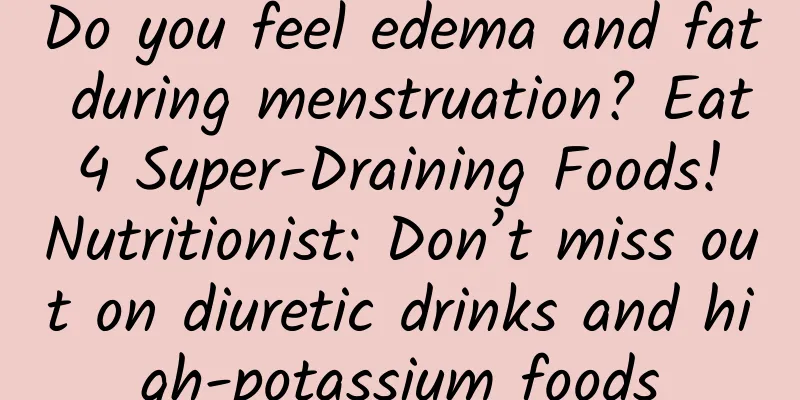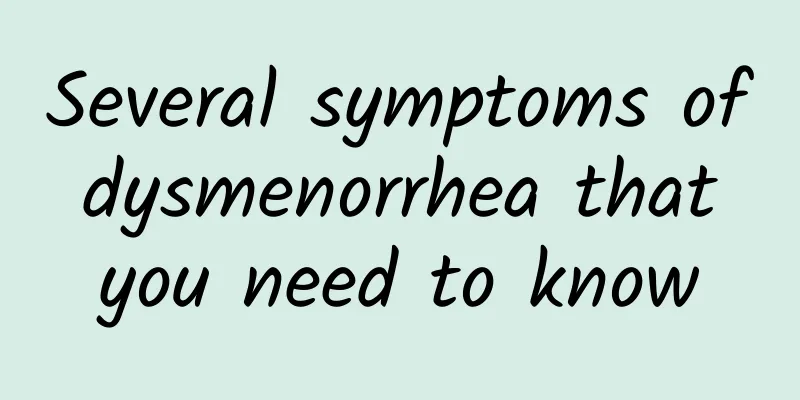Do you feel edema and fat during menstruation? Eat 4 Super-Draining Foods! Nutritionist: Don’t miss out on diuretic drinks and high-potassium foods

|
Girls face uncomfortable symptoms during menstruation every month. In addition to the common menstrual pain and heavy menstrual bleeding, some girls even experience edema during their period, including swelling of the face and feet, making them look like moon faces or elephant legs, and looking fat and swollen, which is very troublesome. Nutritionists recommend consuming 4 types of "super-draining" foods to reduce edema, such as coffee diuretic drinks, to let natural diuretics help! Why are girls prone to edema during menstruation? Looking puffy? It is mainly due to the influence of the hormone estrogen during menstruation, which stimulates the kidneys to absorb water and salt, causing the body's water metabolism to deteriorate. It may also be due to pelvic congestion and the enlarged uterus compressing the blood circulation of the lower limbs, resulting in edema. Lack of exercise may also be the cause of edema. Nutritionist Cheng Hanyu finally reminded that if you have such a problem, it is recommended to make slight adjustments to your diet and let natural diuretics help you. By adjusting what you eat and drink, it can help the body excrete excess water and balance the excess sodium. Coffee contains caffeine, which can help diuresis and accelerate water metabolism. 【4 types of foods that reduce edema】 1. Diuretic drinks Coffee contains caffeine, which can help diuresis and accelerate water metabolism. But if you want to use coffee to reduce edema, how much should you drink? In fact, studies suggest that you should drink 2 to 3 cups of coffee (about 250-300 mg of caffeine). High doses of caffeine have a diuretic effect. In addition, green tea and black tea also contain caffeine, which has a mild diuretic effect. The premise is that people who don’t usually have the habit of drinking tea will feel the most obvious effect of reducing edema. If you want to eliminate sodium and reduce edema, you can consider eating foods high in potassium. Soy milk is rich in water and potassium ions, and it is recommended to drink at least 300ml at a time. Hibiscus tea is also rich in water and high in potassium ions, so people with edema may want to try it. Recommended diuretic foods: coffee, green tea, black tea, soy milk, and roselle tea. 2. High Potassium Foods Potassium is necessary to excrete sodium, urinate and reduce edema. Potassium helps maintain fluid balance to reduce water retention in the body. Balances the effects of sodium to prevent fluid accumulation and edema, as well as increase urine production. Recommended high-potassium foods: bananas, kiwi fruit, tomatoes, and water spinach. 3. High-magnesium foods Magnesium is involved in the function of more than 300 enzymes in the body, allowing the body to metabolize normally. Sufficient magnesium can help reduce edema problems. Some studies have also found that magnesium supplementation (250 mg) can help reduce symptoms of premenstrual syndrome (PMS), including bloating and fluid retention. Recommended high-magnesium foods: green vegetables, 85% dark chocolate, cashews, and seaweed. 4. Vitamin B6 Vitamin B6 is a water-soluble vitamin that can regulate fluid balance and help reduce edema problems. Recommended foods containing vitamin B6: kelp, chicken, seafood, and tofu skin. Nutritionist Cheng Hanyu finally reminded that severe edema may mean that there is something wrong with the body, such as kidney disease, lymphatic system problems, and infection. If you have these symptoms, remember to see a doctor first. (Photo provided by nutritionist Cheng Hanyu) Avoid foods that cause edema Heavy salty food Sodium binds to water in the body and is involved in the balance of fluid inside and outside of cells. If you often eat a high-salty diet and a high-sodium diet, the concentration of extracellular sodium ions will increase, which will absorb a large amount of water in the body and cause swelling and edema, and may even cause blood pressure problems. Highly salty foods: For example, bacon, high-sodium dips, hot and sour soup, and beef broth. Refined carbohydrates Refined carbohydrates often have added sugars and are low in dietary fiber, which can cause rapid spikes in blood sugar and insulin. The high-insulin state may increase reabsorption by the kidneys, leading to more sodium retention. Refined carbohydrate foods: such as bread. Nutritionist Cheng Hanyu finally reminded that edema is the accumulation of excessive fluid in the tissue spaces outside the blood vessels. Unlike obesity, edema manifests as obvious depression when pressing with fingers on areas with less subcutaneous tissue, such as the front of the calf and ankle; or facial swelling, slightly stiff joints, and large fluctuations in weight are all manifestations of edema. Severe edema may indicate a physical condition, such as kidney disease, lymphatic system problems, or infection. If you have these symptoms, remember to see a doctor first. Nutritionist Cheng Hanyu Facebook |
Recommend
Ovarian cyst malignancy risk
The chance of ovarian cysts becoming malignant is...
What are the symptoms of uterine fibroids? What causes uterine fibroids?
What are the symptoms of uterine fibroids? What c...
How long does it take to treat bacterial vaginosis?
Bacterial vaginosis often appears at the same tim...
What are the dangers of ovarian cysts?
A considerable number of female friends do not kn...
Experts explain what are the main causes of cervical hypertrophy
Cervical hypertrophy is a common gynecological di...
Why does adenomyosis cause early menstruation?
Why does adenomyosis cause early menstruation? 1....
Detailed analysis of the symptoms of vaginitis
The symptoms of early vaginitis should be a commo...
Will uterine fibroids cause infertility? What are the hazards of uterine fibroids?
Will uterine fibroids affect pregnancy? Regarding...
What are the early symptoms of ovarian cysts and how to check them?
What are the early symptoms of ovarian cysts? How...
The main cause of chronic pelvic inflammatory disease
Chronic pelvic inflammatory disease is very commo...
What are the most common causes of dysmenorrhea?
Dysmenorrhea is a common phenomenon in life. It i...
People with allergic constitution cannot grow up. Find out the cause and prescribe the right medicine
Parents always hope that their children will beco...
Remove the overflowing meat! Do the "Lizard Pose" back slimming yoga to restore the skinny beauty
A beautiful and skinny back is like a woman's...
Unclean sexual life and excessive cleaning are the main causes of second-degree cervical erosion
Cervical erosion is a disease that female friends...
What are the symptoms of irregular menstruation
Irregular menstruation is a common gynecological ...

![[Video version] Is obesity caused by excessive moisture? Tangerine peel, Poria cocos, and Hawthorn can eliminate dampness, resolve phlegm, and reduce weight](/upload/images/67dcf8240e7e0.webp)







